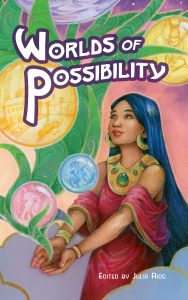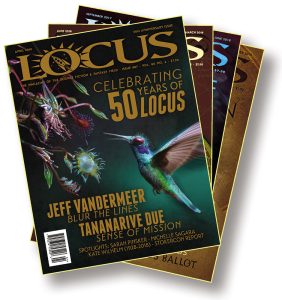Escape Pod, Worlds of Possibility, and Samovar: Short Fiction Reviews by Charles Payseur
 Escape Pod 10/31/24
Escape Pod 10/31/24
Worlds of Possibility 10/24
Samovar 10/28/24
Escape Pod celebrated Halloween with Addison Smith’s “Mother Death Learns a Trick”, which finds the narrator passing by an old AI robot named Mother Death, who normally predicts the demise of anyone she sees. She becomes part of the background, at least until she starts predicting her own death, which knocks the narrator out of their cycle of indifference and prompts them to take her home and clean her up, repairing what is reparable in her body and mind. And really that’s the core the story builds around, the ways that people often gloss over what they are accustomed to, failing to reach out of a fear of disrupting what is familiar. Luckily for the narrator and Mother Death, this intervention doesn’t come too late, and Smith weaves a warm and uplifting story out of what might otherwise have been tragedy. It’s a lovely read.
The October Worlds of Possibility starts strong with Valerie Kemp’s “What the Crows Know”, in which Cora is suffocating in the small town she lives in, with a family that rarely is around, and a single close friend, Silas, who seems able to see through her falsehoods. So she pushes him away, seeking to inhabit fully the lies she tells about herself and her desires – lies she thinks are the key to escaping the town and getting somewhere she can belong. Increasingly, though, she finds herself waking up in the woods without knowing how she got there, and slowly she must face the power she has building within. Kemp captures so well the push and pull between the desperate need to escape a cage and the desire to be accepted authentically, showing how for Cora they seem like opposite directions when in reality there’s power and even magic in rejecting the false dichotomy and finding her own path. The issue closes with the charming “The Witch’s Cat” by Julia LaFond, starring Caspian, a cat who has been waiting (not quite so) patiently for his human, Patty, to realize she’s a witch. Unfortunately, she comes from an otherwise magic-less family, so hasn’t been trained in her art, and can neither hear Caspian’s advice nor see the pattern in the strange events surrounding her. But the truth is, without knowing about her power, she’s vulnerable, and Caspian has made it his job to protect her in the meantime. When the going gets tough, he’ll have to weigh his pride and self-preservation against his care and compassion – which for a cat might seem like an easy choice, but which LaFond does stellar work in exploring.
October brought a new issue of Samovar translated speculative fiction, including the captivating “Because Flora Had Existed. And I Had Loved Her” by Anna Martino. The story is told in snippets and excerpts from interviews and other texts by or about the author Pedro Zephyr, the pseudonym of a man who, when he was young and poor, took money to be injected with something mysterious that gave him vivid dreams in which he fell in love and fathered a child. Back in the waking world, though, he found a different job, started writing, and grew older, until he met the woman from his dreams… or kind of. Martino does a fine job building a mystery around Zephyr, who in person is reserved and straightforward, but who has drawn a kind of mythology around himself because of his dreams, because of what might be a kind of time travel he’s taken part in. It’s a fascinating and rewarding read. The issue’s poetry, “Journey” by Bindu Tiji (translated by Lakshmy Nair), is also well worth checking out, as it explores the nature of art and creativity in a narrator who describes their own imagination blooming in a desert, in a kind of lack of nourishment. And at first they feel a desire to escape through their art, but ultimately find themself pulled back to the desert, creating in order to reach others trying to bloom as they did, in the desert, rather than in the more bountiful or populated places. Tiji is careful not to imply that art is better for the harshness the desert represents – I don’t feel an implication that great art necessitates hardship. Rather, the poem celebrates the beauty and inspiration found there, and the narrator’s choice to see that rather than seek escape from it. It’s wonderful.
Recommended Stories
“What the Crows Know”, Valerie Kemp (Worlds of Possibility 10/24)
“Because Flora Had Existed. And I Had Loved Her”, Anna Martino (Samovar 10/28/24)
Charles Payseur is an avid reader, writer, and reviewer of speculative fiction. His works have appeared in The Best American Science Fiction and Fantasy, Lightspeed Magazine, and Beneath Ceaseless Skies, among others, and many are included in his debut collection, The Burning Day and Other Strange Stories (Lethe Press 2021). He is the series editor of We’re Here: The Best Queer Speculative Fiction (Neon Hemlock Press) and a multiple-time Hugo and Ignyte Award finalist for his work at Quick Sip Reviews. When not drunkenly discussing Goosebumps, X-Men comic books, and his cats on his Patreon (/quicksipreviews) and Twitter (@ClowderofTwo), he can probably be found raising a beer with his husband, Matt, in their home in Eau Claire, Wisconsin.
This review and more like it in the January 2025 issue of Locus.
 While you are here, please take a moment to support Locus with a one-time or recurring donation. We rely on reader donations to keep the magazine and site going, and would like to keep the site paywall free, but WE NEED YOUR FINANCIAL SUPPORT to continue quality coverage of the science fiction and fantasy field.
While you are here, please take a moment to support Locus with a one-time or recurring donation. We rely on reader donations to keep the magazine and site going, and would like to keep the site paywall free, but WE NEED YOUR FINANCIAL SUPPORT to continue quality coverage of the science fiction and fantasy field.
©Locus Magazine. Copyrighted material may not be republished without permission of LSFF.






